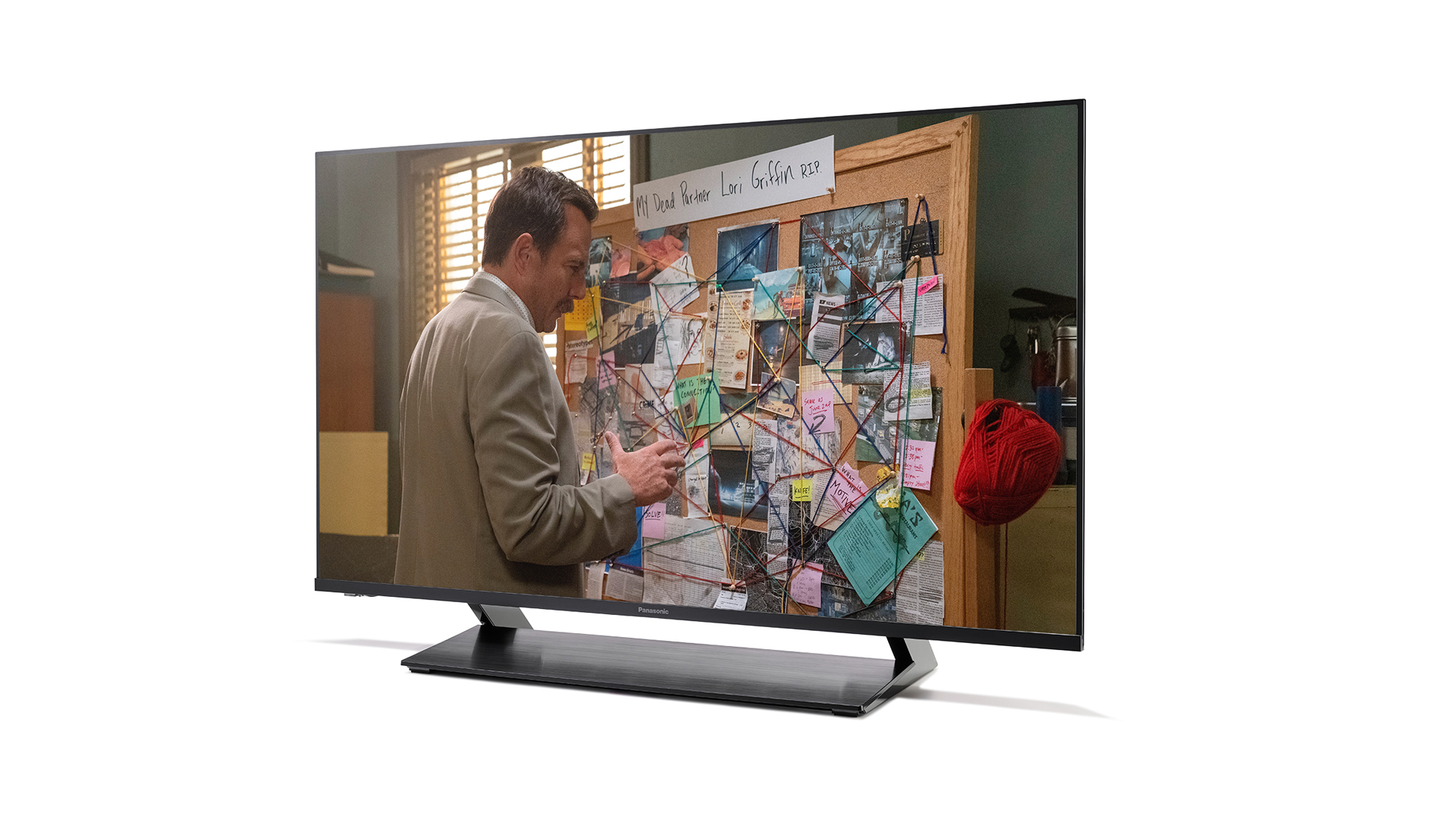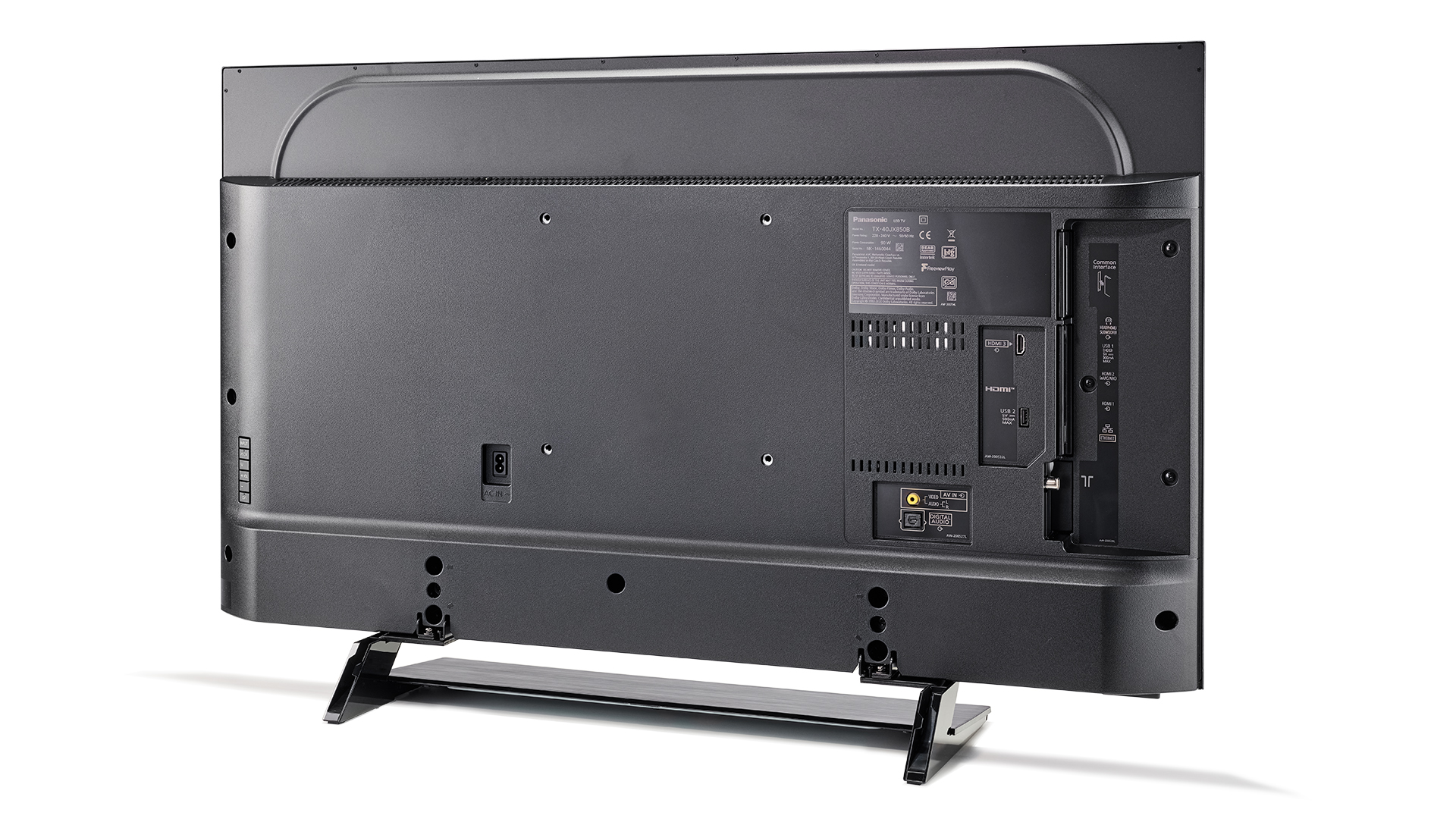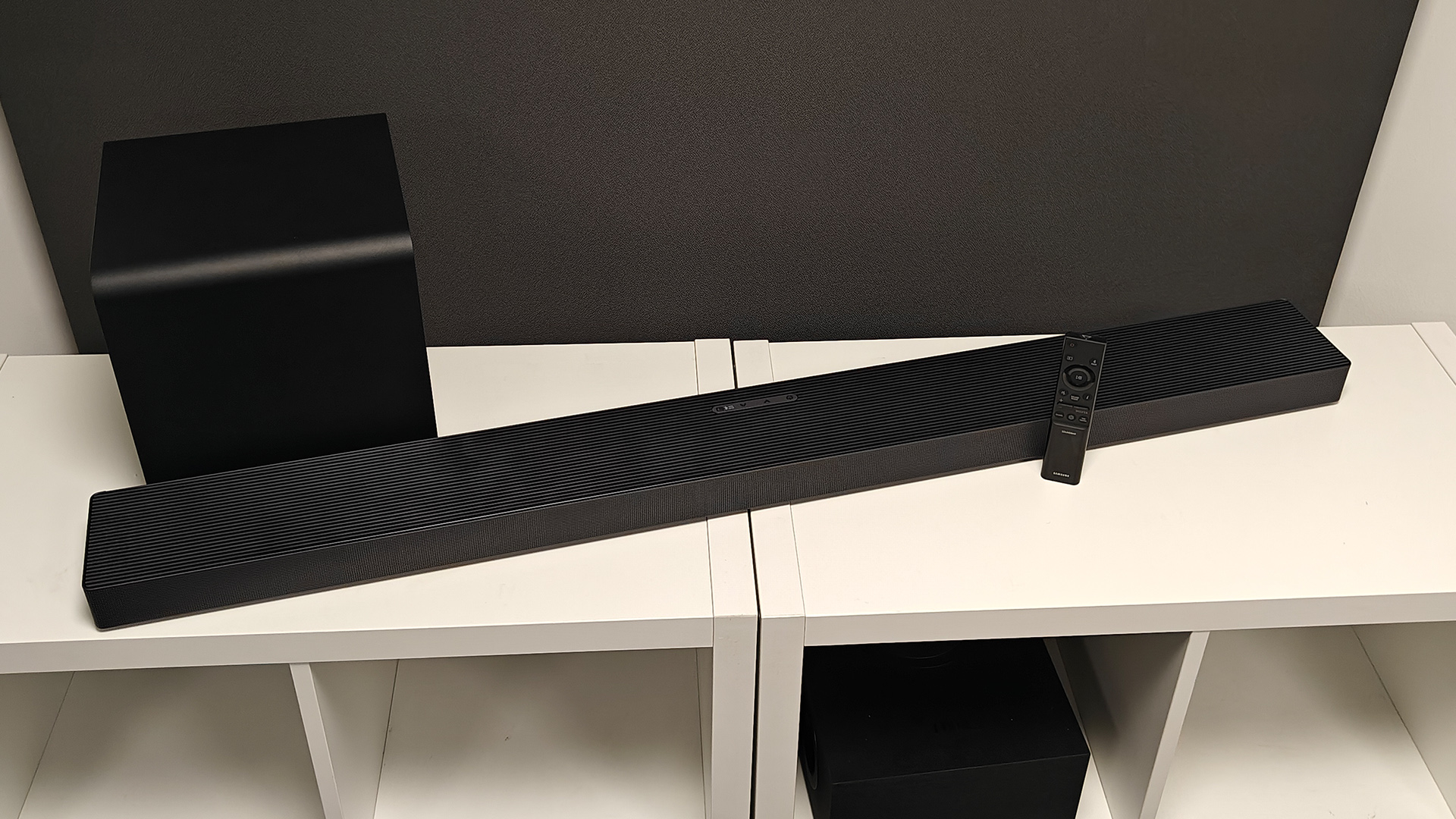What Hi-Fi? Verdict
The TX-40JX850B isn’t cheap – but the best things in TV life seldom are.
Pros
- +
Bright panel excels with HDR
- +
Impressive sound for a small TV
- +
Strong picture processing
Cons
- -
Costs more than its 50-inch sibling
- -
Smeary motion
- -
No 4K/120Hz support
Why you can trust What Hi-Fi?
While we’ve been testing TVs long enough to remember when a 40-inch TV would have been considered colossal, these days 40-inch TVs such as Panasonic’s TX-40JX850B are pretty much the diddy men of the TV world. So much so that they’re as likely to turn up in a bedroom or study as they are in a main living room.
This has seen a degree of homogenisation start to creep into the 40-inch market, as TV makers find themselves having to focus more on price than premium features. The Panasonic TX-40JX850B, though, is having none of this. Both its panel specification and features establish it as having the potential to be a genuinely high-end performer.
Price
The TX-40JX850B is currently available in the UK for £599. Panasonic no longer sells TVs in the US or Australia, though, so you won’t be able to pick up a JX850 in either of those territories.
The TX-40JX850B is relatively expensive by today’s 40-inch TV standards. There are actually 50- and even 55-inch TVs fairly widely available for the same sort of money (or less). Crucially, though, the JX850 series sits quite high up in Panasonic’s current UK LCD range – just one rung down from the flagship JX940 series, in fact. As you’d expect, this means it’s much better featured, especially when it comes to picture features and tweaks, than many 40-inch TV rivals.
There are also 50-inch, 58-inch and 65-inch JX850s, costing £530, £600 and £1000 respectively. And yes, you read that right: you really can get the 40JX850’s 58-inch sibling for the same price, and its 50-inch sibling for £70 less. Of course, we can’t vouch for the quality of the JX850 in these larger sizes until we test them – there are plenty of issues that could be introduced with the larger panels.
Design

The TX-40JX850 enjoys a suitably premium design. The screen frame is extremely slim, but what there is of it has a high quality feel. This is backed up handsomely by the brushed metallic black finish of the rectangular plate-style desktop stand, and the way the screen stands fractionally proud of the sleek bezel.
The stand is a bit of a faff to attach (10 screws!), but once it’s done it feels stable and robust as well as looking the part.
The latest hi-fi, home cinema and tech news, reviews, buying advice and deals, direct to your inbox.
The JX850’s rear is on-trend trim at its upper edge, though as you’d expect (given that panel drivers, tuners, connections and speakers have to go somewhere) the rear depth does grow a fair bit over its bottom two thirds or so.
Partnering the TV is an unusually large, button-heavy remote control. This feels a bit plasticky for a relatively high-end TV, but its layout is mostly thoughtful. Particularly handy are the direct shortcuts at the top to Netflix, Amazon Prime Video, Rakuten, YouTube, Freeview Play and one you can attach to an app of your choice.
Features

The TX-40JX850B gets off to a strong start by using a VA LCD panel rather than an IPS (in-plane switching) one. While, as we’ll see, this results in limited viewing angles, experience suggests it should produce better black levels and contrast.
It’s worth noting that all of the JX850 screen sizes use VA (vertical alignment) panels; there’s no mixing of panel types within the series as often happens in today’s LCD TV world.
Less promising and perhaps a bit disappointing for a TV that sits relatively high up Panasonic’s TV range is the TX-40JX850’s use of edge-based rather than direct (behind the screen) LED lighting. Edge-based lighting usually leads to reduced contrast and black level performance, and more persistent backlight clouding issues.
Hopefully mitigating any potential edge LED issues is the JX850’s Local Dimming Pro technology. This is not local dimming in the sense we usually understand, though. Rather than separate ‘zones’ of the edge LED lighting being capable of delivering brightness levels independently of their neighbours, Local Dimming Pro refers to a combination of full frame dimming and more control over the light shutters that are such a key part of LCD technology.
Panasonic boasts that the JX850 uses an ‘HDR Bright Panel Plus’ screen capable of delivering more of the brightness and colour that’s so key to a convincing high dynamic range performance. This could turn out to be one of the most compelling reasons to buy a TX-40JX850. So long, anyway, as any brightness advantage isn’t undermined too much by the set’s use of an edge LED lighting system.

Dimensions (hwd) 574 x 901 x 236mm
Processing HCX AI Processor
Screen size 40 inches
Native resolution 3840x2160
Input lag in game mode 10.5ms
Panel type VA with edge lighting
More positive HDR news finds the TX-40JX850B persisting with Panasonic’s excellent policy of supporting all the key HDR formats: HLG, HDR10, HDR10+ and Dolby Vision. This means that the TV can play the best version of almost any HDR source you feed it. There’s no stubborn sticking to only supporting either HDR10+ or Dolby Vision, as we see with TVs from Samsung, LG and Sony.
Another sign of the JX850’s premium LCD status is its HCX AI Processor ‘brain’. This isn’t as powerful or wide-ranging in its measures as the Pro version deployed on Panasonic’s step-up JX940s, but it still features AI tools for recognising and responding to both different types of image content and differing room conditions.
The HCX name also indicates that the processing is built on picture know-how developed over the years in conjunction with Panasonic’s extensive contacts in the Hollywood filmmaking community. So we can hopefully expect a picture that focuses on accuracy – at least with some of the TV’s presets. The TX-40JX850B underlines Panasonic’s long-running drive to deliver images ‘as the director intended’, too, by including the UHD Alliance’s independently calibrated Filmmaker Mode.
If you like to tinker with picture settings yourself, the TX-40JX850B provides a pretty lengthy suite of picture adjustment options including multiple settings for an adaptive Backlight Control system, standard and MPEG noise reduction, colour remastering, resolution ‘remastering’, and separate Intelligent Frame Creation (IFC) and Clear Motion options for better motion playback. The IFC system interpolates extra frames into the picture to reduce judder, while the latter introduces black frames to create a more cinematic feel to motion.
An advanced feature menu provides full colour, gamma and white balance management, too, as well as another Contrast Control feature with Off, Custom and Auto features. The Custom mode provides some reasonably flexible and appreciated fine tuning over the set’s Adaptive Gamma Control (middle level of luminance), black expansion and Clear White (essentially white temperature) picture elements.
You can also turn on or off dynamic tone mapping with HDR10 sources, and activate a Game mode that reduces the screen’s input lag to an excellent 10.5ms. While we’re on the subject of gaming, it’s a little disappointing to find that despite sitting fairly high up Panasonic’s LCD range, the TX-40JX850B’s three HDMIs don’t support either 4K at 120Hz or VRR gaming. The only ‘next-gen’ gaming feature on the table is Automatic Low Latency Mode (ALLM) switching.
This HDMI 2.1 feature is joined by one other: support for eARC, which makes it possible to pass lossless Dolby Atmos sound on to compatible soundbars and AVRs. The TV can also decode Dolby Atmos itself, but the set’s 2 x 10W speaker system will clearly be limited in what it can do with such channel-rich soundtracks.
The TX-40JX850B’s smart features, finally, are provided by Panasonic’s My Home Screen 6.0 platform. This continues to be an attractive, easily customised and efficient smart system that’s also recently been significantly bolstered by the addition of support for the previously long-term absent Disney+ and Apple TV+ apps.
Picture

Kicking off with the areas of picture quality that typically causes relatively affordable LCD TVs the most trouble, contrast and black levels, the TX-40JX850 proves to be handsomely above par.
There is a little greyness in any part of the picture that should look black, and the intensity of this greyness can increase with dark HDR shots punctuated by one or two very bright highlights. However, the issue – along with some extremely rare backlight ‘shifting’ with the otherwise useful Adaptive Backlight setting active, and some very faint backlight clouding over sections of the screen’s left side – remains impressively mild compared with many rivals, leaving black levels that are actually much deeper than those of many small and similarly affordable LCD rivals. In fact, the backlight shortcomings are so mild that they can be almost completely removed from the viewing experience by introducing even just a small amount of ambient light to your room.
It’s genuinely hard to believe that you’re watching a screen illuminated by edge-based lighting (though we should add that the edge lighting has the potential, at least, to be more problematic with the larger screens in the JX850 range).
The TX-40JX850’s black level prowess is all the more surprising given that it sits right alongside some seriously potent brightness by small LCD TV standards. This enables high dynamic range images to look much brighter and contain much more genuine light range than we typically see on small LCD screens, suggesting that Panasonic’s unusual Local Dimming technology really does make a difference.
Shadow detailing in dark scenes is good for the most part too, while dark picture areas also remain largely free of the sort of noise lesser TVs can exhibit. At the other end of the brightness spectrum, the JX850’s dynamic tone mapping option does an excellent job of making sure that subtle details aren’t ‘clipped’ out of the brightest highlights of HDR images.
The TX-40JX850’s colour performance is excellent. The screen’s strong brightness and contrast play a big part in this, introducing more colour volume for the wide colour gamuts carried with almost all HDR content. Crucially, though, the 40JX850 sweats the small colour stuff unusually well too, with its HCX processor revealing subtleties of shading and tone not routinely found on today’s relatively small TVs. This subtlety makes images look natural and three dimensional, too.
There’s none of the ‘rough’, compressed look to dark colours, either, that can afflict mid-range and lower-end TVs. As a result, low-lit skin tones and highly detailed dark objects look convincing and refined, rather than plasticky or ‘clumpy’.
Colours are not quite as heavily saturated as they are on the best premium TVs – possibly as a result of the screen’s peak brightness pushing slightly further than the colour gamut can follow. For its money, though, and especially considered against other 40-inch screens, the TX-40JX850’s colours are well above par overall.
The JX850’s combination of brightness and nicely saturated colours make it more adept than most rivals when it comes to switching easily between dark and bright room conditions. A trait that helps its light-reactive ‘ambient modes’ deliver unusually useful results, too.
There’s more evidence of the power of the 40JX850’s premium processor, meanwhile, in the upscaling of HD and SD sources to the screen’s native 4K resolution. The upscaling engine does a particularly great job of spotting and removing source noise, leaving results that typically look significantly more polished, dense and three-dimensional than the original images.
One thing the 40JX850’s upscaled pictures don’t look, however, is spectacularly sharp compared with those of some rivals. And actually, the slightly soft finish to upscaled images carries through into the 40JX850’s native 4K playback. There just isn’t that same sense of snap and HD-thrashing clarity we see with the sharpest 4K screens. This isn’t a function of the screen’s relatively small size, either; we’ve seen plenty of similarly small 4K screens look sharper than this Panasonic.
The main cause of the 40JX850’s slightly soft images is actually its motion performance. While judder is handled smartly enough, even without Panasonic’s Intelligent Frame Creation system in play, horizontal motion can suffer both a loss of resolution and some noticeable smearing as the screen’s LCDs struggle to refresh fast enough to track the action.
No setting of Panasonic’s IFC motion processing solves this seemingly hardware-level issue satisfyingly, either – especially as the medium and high settings introduce noticeable unwanted processing side effects.
The Clear Motion option helps a little with 24p movie sources, but it unfortunately causes the image to dim more than we feel comfortable with.
One other niggle is that the 40JX850’s contrast charms fade quite heavily if you find yourself having to watch the screen from an angle of any more than 20 degrees or so off axis. This probably won’t be a major issue for most households, and is an issue that affects pretty much all LCD TVs to some extent. It’s still worth bearing in mind, though, if you have a larger than usual number of seating positions to cater for.
Sound

The 40JX850 gets surprisingly good value out of its 2x10W speaker set up. The sound is cast far beyond the TV’s physical boundaries for starters, creating a wall of sound that dwarfs the screen and pulls you into the action. The sound is more ‘forward’ than expected, too, pushing into your room rather than sounding as if everything’s taking place where the TV’s speakers are – behind the screen.
The mid-range is strikingly open and wide-ranging, helping even the most intense and dense soundtrack moments to avoid sounding compressed or hemmed in. There’s also enough headroom in the speaker to handle both abrupt and slow-building volume and soundtrack density transitions surprisingly effectively – all without any crackling or distortions from the speakers, or unwanted buzzes from the cabinet.
Audio detailing is exceptionally strong too, whether it’s general ambient effects or specific sharp object sounds. There’s even a credible sense of sounds being at least layered into a wall of sound with Dolby Atmos soundtracks, even if, inevitably, the two speakers can’t create a true three-dimensional audio space. The strong staging helps keep dialogue sound locked to the screen, too.
The bass depths the 40JX850 can reach are, inevitably, limited in scope. However, while it comes up fairly light when taking on the massive bass drops and rumbling sounds common in Blade Runner 2049, its speakers almost always stay just the right side of collapse. And we’d much rather have a TV sound system that knows and works within its limitations than one that just goes for broke all the time regardless of whether its speakers can actually handle that.
It’s worth adding, too, that the 40JX850’s midrange is open and dynamic enough to disguise the bass lightness.
Verdict
While some motion issues prevent the TX-40JX850 from scoring the full five stars, its all-round performance is still strong enough to prove that there’s plenty of life in the smaller LCD TV market yet. It also boasts a strong feature count that’s only let down by a (predictable) lack of 4K/120Hz gaming support.
We guess that the TX-40JX850 costing more than its 50-inch sibling and the same as its 58-inch sibling does raise questions about its value for money. In reality, though, people who want a 40-inch TV likely don’t want or can’t handle a 50 or 58-inch TV. And when it comes to 40-inch TVs, you’ll struggle to find a more big-hearted all-rounder.
SCORES
- Picture 4
- Sound 4
- Features 4
MORE:
Read our review of the Samsung UE43AU7100
Also consider the Hisense 43A6GTUK
Check out Toshiba's 50UK3163DB set
Best 40, 42 and 43-inch TVs 2022: these 'small' TVs are great value
What Hi-Fi?, founded in 1976, is the world's leading independent guide to buying and owning hi-fi and home entertainment products. Our comprehensive tests help you buy the very best for your money, with our advice sections giving you step-by-step information on how to get even more from your music and movies. Everything is tested by our dedicated team of in-house reviewers in our custom-built test rooms in London, Reading and Bath. Our coveted five-star rating and Awards are recognised all over the world as the ultimate seal of approval, so you can buy with absolute confidence.

